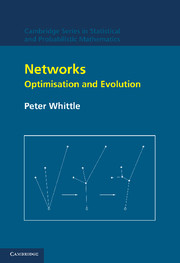Book contents
- Frontmatter
- Contents
- Acknowledgements
- Conventions on notation
- Tour d'Horizon
- Part I Distributional networks
- 1 Simple flows
- 2 Continuum formulations
- 3 Multi-commodity and destination-specific flows
- 4 Variable loading
- 5 Concave costs and hierarchical structure
- 6 Road networks
- 7 Structural optimisation: Michell structures
- 8 Computational experience of evolutionary algorithms
- 9 Structure design for variable load
- Part II Artificial neural networks
- Part III Processing networks
- Part IV Communication networks
- Appendix 1 Spatial integrals for the telephone problem
- Appendix 2 Bandit and tax processes
- Appendix 3 Random graphs and polymer models
- References
- Index
1 - Simple flows
Published online by Cambridge University Press: 23 November 2009
- Frontmatter
- Contents
- Acknowledgements
- Conventions on notation
- Tour d'Horizon
- Part I Distributional networks
- 1 Simple flows
- 2 Continuum formulations
- 3 Multi-commodity and destination-specific flows
- 4 Variable loading
- 5 Concave costs and hierarchical structure
- 6 Road networks
- 7 Structural optimisation: Michell structures
- 8 Computational experience of evolutionary algorithms
- 9 Structure design for variable load
- Part II Artificial neural networks
- Part III Processing networks
- Part IV Communication networks
- Appendix 1 Spatial integrals for the telephone problem
- Appendix 2 Bandit and tax processes
- Appendix 3 Random graphs and polymer models
- References
- Index
Summary
The setting
By ‘simple flow’ we mean those cases in which a single divisible commodity is to be transferred from the source nodes of a network to the sink nodes, and the routing of this transfer is determined by some extremal principle. For example, one might be sending oil from production fields to refineries in different countries, and would wish to achieve this transfer at minimal cost. (For the ideas of this chapter to be applicable one would have to assume that all oil is the same – if different grades of crude oil are to be distinguished then the more general models of Chapter 3 would be needed.) This is the classical single-commodity transportation problem of operations research (see e.g. Luenberger, 1989). However, we mean to take it further: to optimise the network as well as the routing. Further, in Chapters 4 and 5 we consider the radical effect when the design must be optimised to cope with several alternative loading patterns (i.e. patterns of supply and demand) or with environmental pressures.
Another example would concern the flow of electrical current through a purely resistive network. This has virtually nothing to do with the practical distribution of electrical power, which is achieved by sophisticated alternating-current networks, but the model is a very natural one, having practical implications. For given input/output specifications the flow through the network is determined physically: by balance relations and by Ohm's law. However, Ohm's law can be seen as a consequence of a ‘minimal dissipation’ criterion, so that one again has an extremal principle, this time a natural physical principle rather than an imposed economic one.
- Type
- Chapter
- Information
- NetworksOptimisation and Evolution, pp. 9 - 23Publisher: Cambridge University PressPrint publication year: 2007

